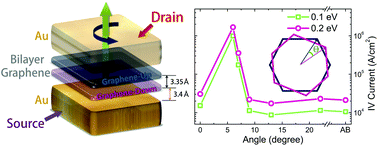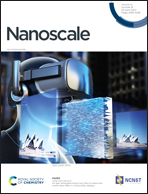Effectively modulating vertical tunneling transport by mechanically twisting bilayer graphene within the all-metallic architecture†
Abstract
Bilayer graphene possesses new degrees of freedom for modulating the electronic band structure, which makes it a tempting solution for overcoming the intrinsic absence of sizeable bandgaps in graphene and designing next-generation devices for post-silicon electronics. By twisting bilayer graphene, interlayer hybridized and twist angle-dependent van Hove singularities in the electronic band structure are generated and expected to facilitate the vertical tunneling transport between bilayer graphene. Herein, based on the ab initio quantum transport simulations, we designed a novel all-metallic vertical quantum transport architecture with the twisted bilayer graphene as the transport channel region and Au electrodes as the source/drain contacts to investigate the twist angle-dependent vertical transport properties. Enhancement in the ION/IOFF ratio by 2 orders of magnitude can be achieved by simply twisting the bilayer graphene. Compared to the traditional gate voltage modulation, which tunes the Fermi energy level alone, the current strategy shifts the Fermi energy level of the channel region away from the Dirac cone, moves the Fermi level and the van Hove singularities towards each other and promotes the vertical quantum transport due to the interlayer electronic hybridization. This dual modulation strategy of this novel mechanical gating device thus provides a potential new solution for designing novel vertical transistors.

- This article is part of the themed collection: Celebrating 60 years of the Fujian Institute of Research on the Structure of Matter


 Please wait while we load your content...
Please wait while we load your content...